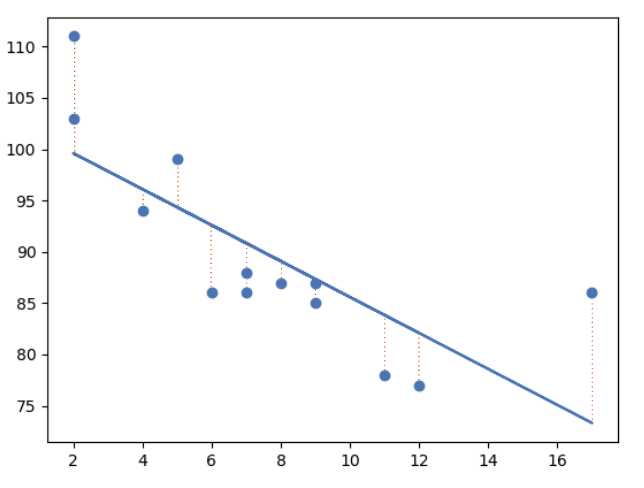数据科学- 线性回归
我们缺少一个影响卡路里燃烧的重要变量,即训练的持续时间。
Duration 与 Average_Pulse 结合在一起可以更准确地解释 Calorie_Burnage。
线性回归
当您试图找出变量之间的关系时,使用术语回归。
在机器学习和统计建模中,这种关系用于预测事件的结果。
在本单元中,我们将讨论以下问题:
- 我们能否得出 Average_Pulse 和 Duration 与 Calorie_Burnage 相关的结论?
- 我们可以使用 Average_Pulse 和 Duration 来预测 Calorie_Burnage 吗?
最小二乘法
线性回归使用最小二乘法。
这个概念是通过所有绘制的数据点画一条线。 这条线的定位方式使其与所有数据点的距离最小。
距离称为"残差"或"错误"。
红色虚线表示数据点到绘制的数学函数的距离。

使用一个解释变量的线性回归
在本例中,我们将尝试使用线性回归预测 Calorie_Burnage 和 Average_Pulse:
实例
import pandas as pd
import matplotlib.pyplot as plt
from scipy
import stats
full_health_data = pd.read_csv("data.csv", header=0, sep=",")
x = full_health_data["Average_Pulse"]
y = full_health_data ["Calorie_Burnage"]
slope, intercept, r, p, std_err = stats.linregress(x, y)
def myfunc(x):
return
slope * x + intercept
mymodel = list(map(myfunc, x))
plt.scatter(x, y)
plt.plot(x, slope * x + intercept)
plt.ylim(ymin=0, ymax=2000)
plt.xlim(xmin=0, xmax=200)
plt.xlabel("Average_Pulse")
plt.ylabel ("Calorie_Burnage")
plt.show()
示例说明:
- 导入您需要的模块:Pandas、matplotlib 和 Scipy
- 将 Average_Pulse 隔离为 x。 将 Calorie_burnage 隔离为 y
- 获取重要的关键值:斜率、截距、, r, p, std_err = stats.linregress(x, y)
- 创建一个使用斜率和截距值返回新值的函数。 这个新值表示相应的 x 值将放置在 y 轴上的哪个位置
- 通过函数运行 x 数组的每个值。 这将产生一个新数组,其中 y 轴具有新值: mymodel = list(map(myfunc, x))
- 绘制原始散点图:plt.scatter(x, y)
- 绘制线性回归线:plt.plot(x, mymodel)
- 定义轴的最大值和最小值
- 标记轴: "Average_Pulse" 和 "Calorie_Burnage"
输出:

你认为这条线能准确预测卡路里燃烧吗?
我们将证明仅靠变量 Average_Pulse 不足以准确预测卡路里燃烧。

